The Acer Swift 3 SF314 Notebook Review: Swift Gets Swifter With Ryzen 4000
by Brett Howse & Andrei Frumusanu on May 5, 2020 8:00 AM ESTDisplay Analysis
Acer offers just a single display option on the 14-inch AMD based Swift 3, which is a 1920x1080 IPS display. Considering the price, this is the right option, although it is interesting that they are offering a 13.5-inch 3:2 Intel based Swift 3 in the SF313-52. The 3:2 works quite well for productivity, although less-so for gaming where 16:9 generally suffers from fewer issues.
There is no touch capability with this display, which is a bit of a shame, but also understandable with the other features offered. Acer did well to hit their target price range, and they made overall good decisions on where to invest. Touch is a nice to have, but not a necessity, although when you are used to having it, it is amazing how often you try to touch the screen.
To see how the display stacks up, the laptop was tested with Portrait Display’s CalMAN software suite. For brightness and contrast, the X-Rite i1Display Pro colorimeter was used, and for color accuracy readings the X-Rite i1Pro 2 spectrophotometer was employed.
Brightness and Contrast
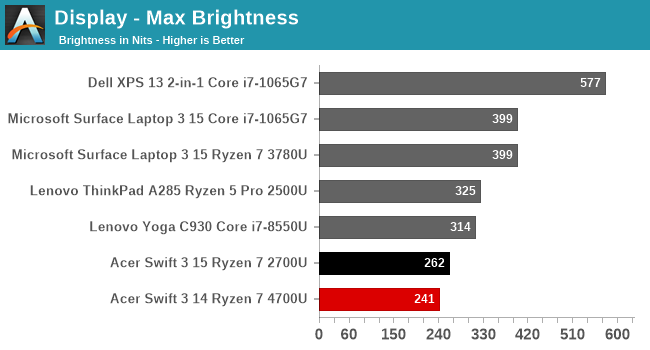
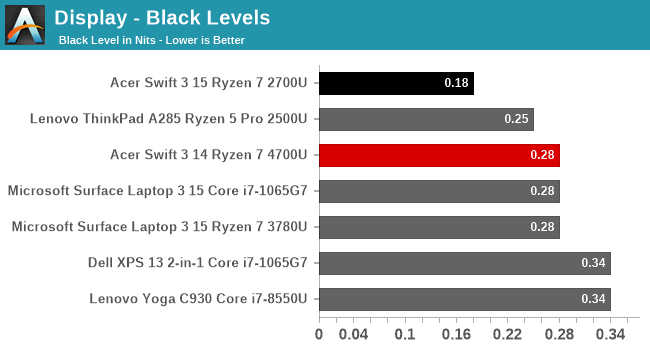
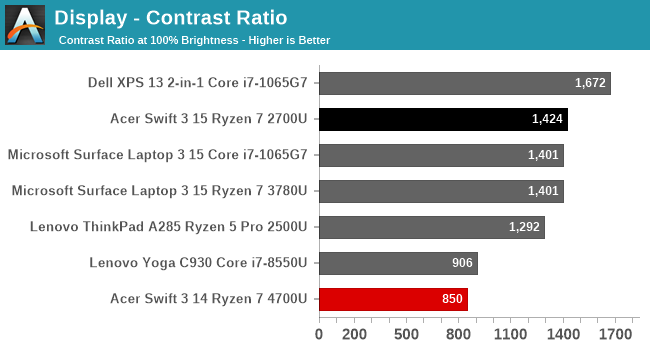
The Acer Swift 3 does not get off to a great start. In a budget notebook, displays tend to be one of the first things on the chopping block. Luckily, we’ve moved past the era where these types of notebooks would offer 1366x768 TN panels, but Acer’s 1920x1080 IPS choice doesn’t offer very good black levels, and their backlight is somewhat weak. It is an inauspicious start.
Grayscale

Grayscale measures the laptops ability to display white levels, from 0% (black) to 100% (white), and the Swift 3 performs quite poorly here. The blue levels are far too strong across most of the range. Gamma is also way off of the expected 2.2 level.
Gamut
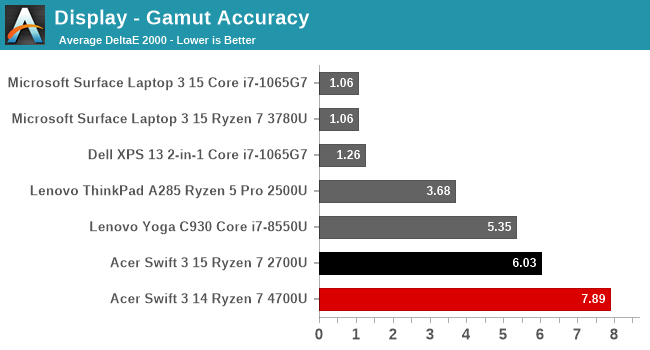
Windows 10 is still an sRGB system first and foremost, so proper sRGB gamut support is required for proper color accuracy. The Acer Swift 3 unfortunately does not cover anywhere near the sRGB gamut, which means that the LED backlighting was likely another area where some money was saved. Although grayscale can be salvaged with some ICC profiles, without full sRGB backlighting this laptop would likely suffer further if an ICC was applied because it simply cannot cover the entire sRGB spectrum.
Saturation
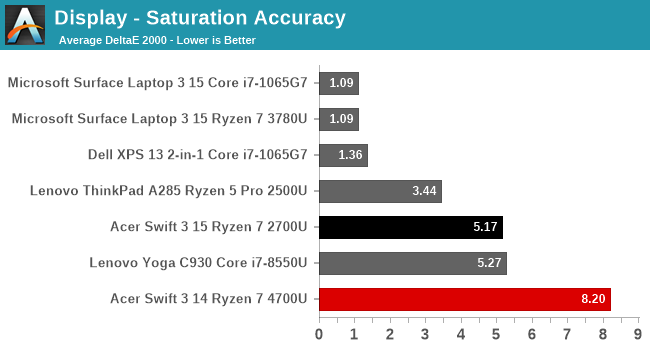
The saturation test covers the primary and secondary colors, but unlike the gamut where they are just measured at 100% level, we test them on 4-bit steps from 0% to 100%. Since we’ve already determined the laptop can’t hit the full sRGB gamut, it is no surprise to see the saturation sweeps suffer.
Gretag Macbeth
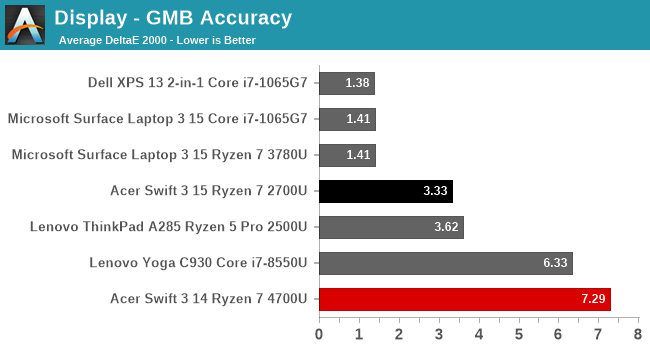
The Gretag Macbeth tests colors off of the primary and secondary axis, including the important skin tones, but with a display that can’t reproduce the entire sRGB range, the Acer Swift 3 naturally performs quite poorly on this test.
Colorchecker
Finally, we have the colorchecker, where you can more easily visualize the color errors with this display. This is a relative test, since any errors in your own display will influence the result, but on the bottom of the swatches is the color requested, and the top shows the color produced by the display. It is not pretty.
Display Conclusion
Overall, despite the poor showing here, the display is in-line with expectations at this price point. Over the last couple of years, there has been a push for better displays, and laptop makers have made the jump to 1920x1080 IPS panels pretty much across the board; so even though this display is poor compared to better IPS-based laptops, it still does offer the good viewing angles an IPS panel enjoys, and 1920x1080 works very well on a 14-inch screen size.
The very poor backlighting really does hamper the capabilities of this notebook. If you wanted to use it for editing photos or video, the internal components like the CPU, memory, and GPU, really would help, but the included display with its lack of sRGB coverage would certainly hinder the work. For basic office tasks, or even gaming, most people who are looking at a laptop at this price point will likely not be too concerned about the display, but just be aware that this one is deficient in several areas.
















191 Comments
View All Comments
Spunjji - Wednesday, May 6, 2020 - link
Deicidium doesn't care that the benchmarks invalidate his talking points. As long as Intel only have 4 cores at 15W, 4 cores will be enough. Once Intel get 8 cores at 15W, he'll find a reason why it suddenly makes sense.SolarBear28 - Tuesday, May 5, 2020 - link
Regardless of whether or not 8 cores is necessary in a budget device, I think its a good policy to get as much CPU as you can for the money, especially in a non upgradable laptop. I have a usable 10 year old laptop because I got more CPU power than i needed at the time of purchase.Spunjji - Wednesday, May 6, 2020 - link
This. If you're keeping a device for more than 4 years, you're buying for the software made then, not now.0iron - Thursday, May 7, 2020 - link
I wish I could give 👍 to your comment!sonny73n - Tuesday, May 5, 2020 - link
@deici“ The extra cores are useless and nothing more than a marketing exercise - no one using this laptop will be doing anything that even requires 4 cores. ”
I open 15 tabs on average with web browser(s). I also transcode movies very frequently. So the more cores the better. We know you’re full of BS, Intel shill.
Dribble - Thursday, May 7, 2020 - link
Having millions of tabs open doesn't require lots of cores, just enough memory. You aren't going to be transcoding movies on a cheap laptop with a little SSD.sonny73n - Thursday, May 7, 2020 - link
@DribbleObviously you’ve never worked with browsers before. More cores is better for multitasking but someone on here said otherwise.
Yes, I’m transcoding a few Disney movies every week for my 4 years old son so he can watch them with his iPad.
I’m not going to explain to you in technical details. If you think “the extra cores are useless...” like Deici does, you’re totally in a different league.
Spunjji - Wednesday, May 6, 2020 - link
"The extra cores are useless and nothing more than a marketing exercise"Maybe, maybe not. Not really your place to say how other people are supposed to use their laptops, is it?
Bear in mind that we only got 4 cores at 15W from Intel *after* AMD announced the original Ryzen APU. Your logic now sounds like theirs when they designed Kaby Lake.
GreenReaper - Thursday, May 7, 2020 - link
Browser tabs, virus checkers, malware, that stream you have going in the corner on your secondary monitor - all of those things take up cores. A lot of software has been redeveloped to use all the cores available to it nowadays.fmcjw - Tuesday, May 5, 2020 - link
Is it because the 8-core throttles more to an even lower power state, spending more time to cool down?I'm also curious to see evaluations of how much of that 25% battery time is consumed by wasted cycles in actual application performance. Probably not a lot on a benchmarks, since the SoC is designed to be shut down idle cores, but in real life the OS probably fires them up for no good reason, probably just because they they're there. I mean this is a mix of apps with legacy UI's and libraries we're talking about, not server optimized cloud applications.
Accordingly, from a software and sustained performance perspective, is it better just to focus on single core performance?
I have a tendency to get a more predictable Core i3-8145U sans Turbo Boost, or a Ryzen 3-3200U with fewer cores, despite them looking poor on benchmarks. I have no idea what I'm missing, but hopefully it's a worthy trade-off. At least there's less throttling due to quicker heat up of quad/hex/octa-cores, longer battery life due to less cores to address, and wasted cycles due to inefficiencies in the application/OS.
Hope this is something Anandtech can investigate? Too many brilliant minds are trained on phone topics, but not the state of affairs in PC land.